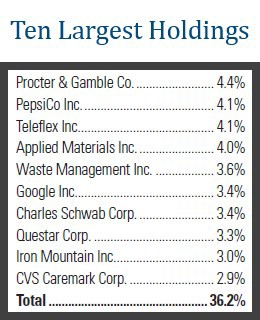We talk a lot on this website about how to increase returns and lower defaults, but at the end of the day our money is simply not worth living for. The reason I work hard to earn a good return on my Lending Club IRA is so that it might enable what is more important: the relationships with my family and friends.
Life is found in living generously. In the day to day, this entails joining into reciprocal life-giving community with others. Yet few realize how every element of our lives can become generous. Beyond caring for friends and family, we can make a tremendous impact on the world in the way we structure our lifestyle, even in how we operate our finances. The ways we earn and spend our money has a tremendous ability to positively impact the lives of those around us.
The Quest for Ethical Underwear
Let me use a somewhat dramatic example: this very day, June 17, underage children are hard at work in Asia sewing clothing for those of us who live in the United States. And I don’t just mean fifteen year olds. Twelve year old kids, children like our own, are hard at work on the clothing we will someday wear. They are people like us with hopes and dreams to have healthy, thriving realities, and we have the ability to make a difference in their lives.
 Yet most of us use their clothing without consideration of their labor. This is not because we are mean-spirited or intentionally exploitative. Quite simply, it is incredibly difficult to ethically dress ourselves. The other day I needed a new pair of boxers, and tried to find some that were made by a company with solid labor standards. Do you know how difficult this task was, even in the city of Seattle? I went to five stores before settling with a nearby American Apparel, and paid a premium for them: $18/pair.
Yet most of us use their clothing without consideration of their labor. This is not because we are mean-spirited or intentionally exploitative. Quite simply, it is incredibly difficult to ethically dress ourselves. The other day I needed a new pair of boxers, and tried to find some that were made by a company with solid labor standards. Do you know how difficult this task was, even in the city of Seattle? I went to five stores before settling with a nearby American Apparel, and paid a premium for them: $18/pair.
I search for ethical clothing because I believe that twelve year old kids should be going to school, not sewing sweatshirts, and when I purchase clothing that believes this I support a market that improves the condition of the world. Children in our world’s poorest nations would have better lives if all of us within the United States made a similar effort to purchase our goods from companies that are considerate of their laborers.
This call is not a burden; indeed, it’s the secret to being happy. If we make our everyday choices considerate of others, we live richly. We leap-frog the quagmire of our self interest and enter into a life that shines wide with meaning.
The (Failed) Quest for a Social Mutual Fund
As I’ve mentioned before, my original foray into ethical investing was through a “socially responsible” mutual fund. This was a fund that promised to consider the environmental and labor standards of the companies it funded. I was moved by how they seemed to trumpet the important of ethics while keeping pace with the S&P 500. Plus they had a beautiful website that simply oozed with photos of mountain ranges.
 Five months after opening this IRA I happened to glance at their holdings, a list of the stocks inside this mutual fund. I was surprised to discover that they were not very socially responsible at all. Their top holdings were in large companies like Pepsi. While I do enjoy the occasional ice-cold cola, I was frustrated by this discovery, frustrated by the lack of intentionality. Surely there had to be a better way to help the world than through sugar water.
Five months after opening this IRA I happened to glance at their holdings, a list of the stocks inside this mutual fund. I was surprised to discover that they were not very socially responsible at all. Their top holdings were in large companies like Pepsi. While I do enjoy the occasional ice-cold cola, I was frustrated by this discovery, frustrated by the lack of intentionality. Surely there had to be a better way to help the world than through sugar water.
Was there such a thing as a truly socially responsible mutual fund? Digging deeper, I found that lots of people were asking this same question (see this article from Forbes). It seems that funds which attempt to provide a solid consistent return often state themselves as socially responsible to simply differentiate themselves from the 8000 other funds out there. Many socially-conscious investors eventually succumb to skepticism like myself, doubtful that there exists a socially responsible way to get a consistent return on investment.
Socially Responsible Lending
This is why I love peer to peer lending. It is an amazing way to invest and save for retirement that also positively impacts those in need. The majority of borrowers are folks trying to consolidate debts and pay off their credit cards at a more favorable rate. Where before somebody was in debt to five different credit card companies paying 25% interest, now they have a single payment with a lower rate.
If you look at the area of LendingMemo that highlights my p2p lending returns, you will notice I am invested in over 700 peer to peer loans. I do not think of these as loans; I think of them as people. I have taken my retirement account and lent it to over 700 individuals and families across the United States who need it, individuals who have good credit reports and worthy stated purposes for my cash. Zoom out from my portfolio to the landscape of peer to peer lending as a whole: over 200,000 people have been issued a peer to peer loan, 200,000+ indebted individuals and families who have found a more reasonable interest rate, giving them precious financial breathing room.
When Will Socially Responsible Investing Discover Peer to Peer Lending?
The curious reality remains, however, that peer to peer lending has yet to catch on for its ethics. Read articles throughout the internet, and the majority of its cheerleaders are busy celebrating its return on investment. So I have to ask: when will the ethical investing movement discover peer to peer lending?
As I said earlier, I think our greatest reward is found in the relationships that comprise our lives. Finances and retirement accounts are important only so far as they enable us to focus on what really matters. In this way, I hope the country begins to involve itself in peer to peer lending, not just for the yield it offers, but because of how refreshing it is to help those in need.
[image credit: NationalGuard “Welcome home” / William Ng “Innie” CC-BY 2.0]

I have been investing at microplace for a couple of years. In fact, it was my first p2p investing experience. It isn’t perfect as many states do not allow theses investments but it is a start. I find this a very fun way to invest.
Cool, thanks Erik.
What is it exactly that makes you believe p2p lending is more or less “moral” or “ethical” than any other kind of investing?
Hi Todd. I feel it is more moral in that it directly goes to where need is great, and with great effectiveness. If I invest $50 in a stock it typically makes little difference to the company, and most of the best companies we invest in are already thriving. P2P lending, in contrast, goes to individuals who have a legitimate dilemma with lots of unconsolidated debt at high interest rates, and my $50 actually goes quite a long ways with each of them.
In this way, it is more moral because p2p lending’s inherent efficiency gives it potential to be a more effective financial medium, both for lenders and borrowers.
Great question :)
Would you expound upon what you perceive to be the “inherent efficiencies” of the US-based P2P platforms, specifically as to those either more “ethical”/”moral”?
I understand the “better rates for borrowers, better returns for investors” spread-capturing pitch versus, example, credit cards – though I’m not sure this is a “reality” rather than merely a “potential” which may, much to our mutual displeasure, evaporate in future (as rates are set by the platforms for reasons which, necessarily, are guided by the goals of their owners – and not necessarily note investor will and/or desire).
Curious if you have any other notions beyond just a happy thought that lending at below current market rates to P2P borrowers may be sustainable one day, since, currently, both US P2P lenders lack “affinity”.
Or were the efficiencies which you mention not tied together with anything so quantifiable as loan rate? (For example, I derive almost zero psychic pay-off from the “direct” indirectness of the note structure – though you apparently place a premium on such. I would understand this if there were an affine connection between yourself and the borrower, and, perhaps you were involved, as an investor, in pricing and/or underwriting the offering – but, absent that, the short audit trail really doesn’t make for social return, for me, given the “must diversify into thousands of strangers to get close to advertised return stats” paradigm which both US platforms operate under currently.)
What’s making you so happy about P2P which might actually be contagious to the average retail investor?
Thank you for the article. Your reasoning does resonate; anything which can be done to tilt the system towards helping each other vs maximize profits through/towards predatory, sociopathic corporations is good in my book. I’m actually looking for P2P lending organizations with lowest borrowing rates – the investment return is secondary for me.